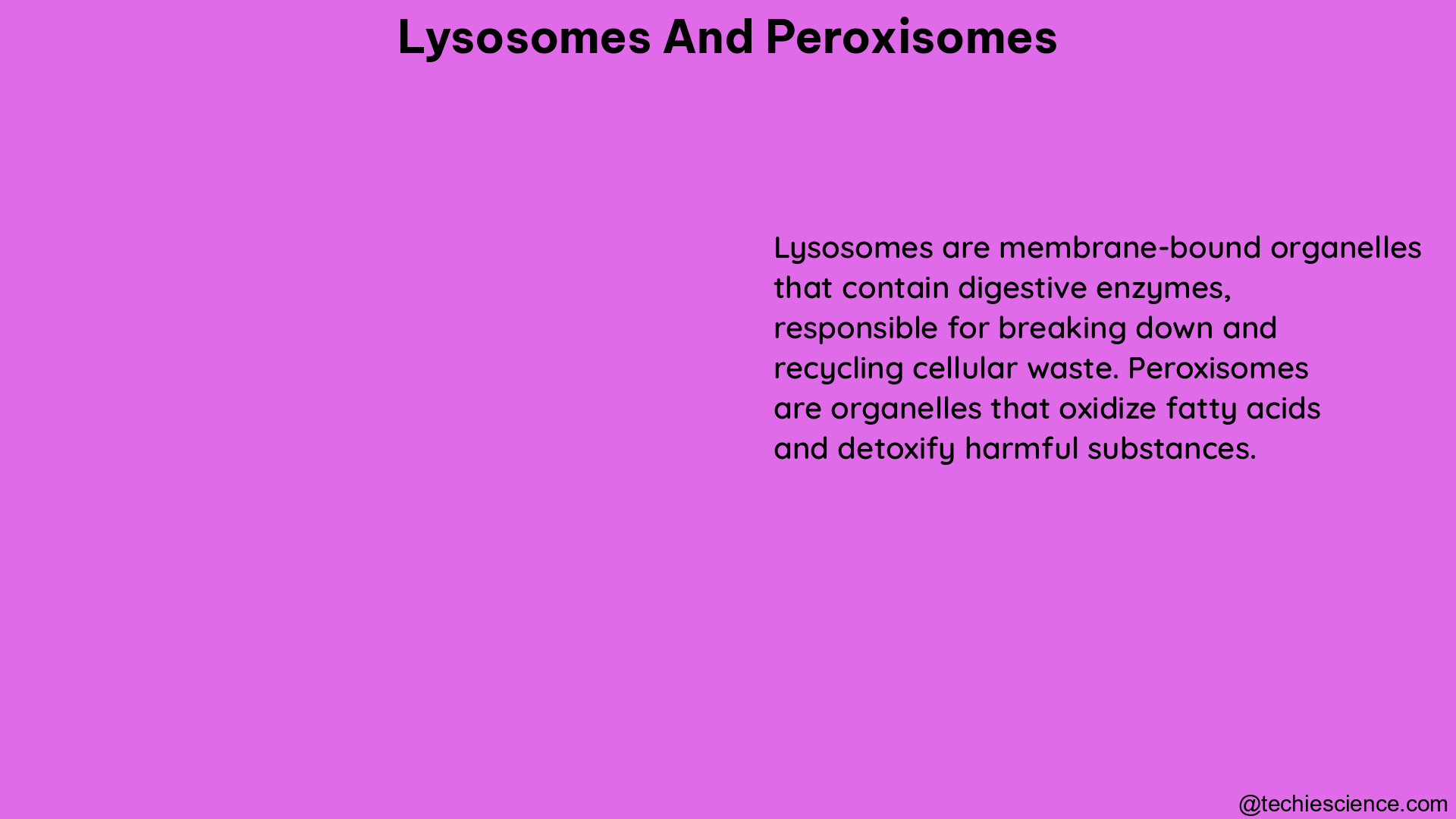Lysosomes and peroxisomes are essential organelles in eukaryotic cells, each with unique biological specifications and functions. These specialized compartments play crucial roles in cellular metabolism, waste management, and overall homeostasis.
Lysosomes: The Cellular Recycling Centers
Lysosomes are roughly spherical bodies enclosed by a single membrane, manufactured by the Golgi apparatus. These organelles contain over 50 different enzymes that can break down various biomolecules, including proteins, lipids, and nucleic acids. Lysosomes are often referred to as the “recycling centers” of the cell, as they play a vital role in the degradation and recycling of cellular components.
Lysosomal Membrane Permeabilization (LMP)
A key characteristic of lysosomes is their ability to fuse with other organelles, such as endosomes and phagosomes, to form a compartment called the endolysosome. This is where the breakdown of materials occurs. Lysosomal membrane permeabilization (LMP) is a crucial event in lysosomal cell death, which can be quantified by various methods:
- Enzymatic Activity: Measuring the release of lysosomal enzymes, such as cathepsins, into the cytosol can indicate LMP.
- Fluorescent Dextran Release: Cells can be loaded with fluorescent dextran, which accumulates in lysosomes. LMP can be detected by the release of the dextran into the cytosol.
- Immunocytochemistry: Antibodies targeting lysosomal membrane proteins can be used to visualize LMP and quantify the extent of lysosomal damage.
- Time-Lapse Imaging: Cells loaded with fluorescent dextran can be imaged over time to observe the dynamics of LMP and lysosomal cell death.
Lysosomal Functions
Lysosomes play a crucial role in various cellular processes, including:
- Autophagy: Lysosomes fuse with autophagosomes to degrade and recycle cellular components, a process known as autophagy.
- Endocytosis: Lysosomes fuse with endosomes to break down and recycle materials that have been taken up by the cell.
- Exocytosis: Lysosomes can fuse with the cell membrane to release their contents outside the cell, a process involved in immune response and tissue remodeling.
- Cholesterol Transport: Lysosomes are involved in the transport of cholesterol from the endoplasmic reticulum to other cellular compartments.
Peroxisomes: The Oxidative Organelles

Peroxisomes, also called microbodies, are about the size of lysosomes (0.5-1.5 µm) and are also enclosed by a single membrane. These organelles are filled with enzymes that catalyze various oxidative reactions, including the breakdown of fatty acids and the detoxification of harmful substances, such as hydrogen peroxide.
Peroxisome Biogenesis and Dynamics
Peroxisomes bud off from the endoplasmic reticulum, and the enzymes and other proteins destined for peroxisomes are synthesized in the cytosol and transported to the peroxisome through a specific targeting signal. Peroxisomes are highly versatile organelles that respond to environmental stimuli with changes in their number, size, and enzyme composition.
Peroxisome Motility and Membrane Contacts
Peroxisomes distribute uniformly in mammalian cells and move along microtubules via kinesin and dynein motors. Their metabolic cooperation with mitochondria and the endoplasmic reticulum is essential for the β-oxidation of fatty acids and the synthesis of myelin lipids and polyunsaturated fatty acids. Peroxisome motility and displacement can be increased when a molecular tether, which associates peroxisomes with the ER, is lost, indicating that membrane contact sites can modulate organelle distribution and motility.
Quantitative Analysis of Peroxisome Dynamics
Researchers have developed methods to quantify peroxisome tracks and dynamics, such as the use of a Hidden Markov Model to analyze peroxisome movement patterns. This allows for a more detailed understanding of the factors that influence peroxisome distribution and function within the cell.
Conclusion
In summary, lysosomes and peroxisomes are essential organelles in eukaryotic cells, each with unique biological specifications and functions. Their quantification and measurement are crucial for understanding their roles in cellular physiology and pathology. By exploring the intricate details of these organelles, we can gain valuable insights into the complex mechanisms that govern cellular homeostasis and function.
References:
- Peroxisome Motility Measurement and Quantification Assay – PMC. (n.d.). Retrieved from https://www.ncbi.nlm.nih.gov/pmc/articles/PMC5603274/
- Methods for the functional quantification of lysosomal membrane permeabilization: a hallmark of lysosomal cell death. (n.d.). Retrieved from https://www.ncbi.nlm.nih.gov/pmc/articles/PMC7611294/
- Quantitative analysis of peroxisome tracks using a Hidden Markov Model. (n.d.). Retrieved from https://www.nature.com/articles/s41598-023-46812-7
- Cholesterol Transport through Lysosome-Peroxisome Membrane Contacts. (n.d.). Retrieved from https://www.sciencedirect.com/science/article/pii/S0092867415001853
- 3.8: Lysosomes and Peroxisomes – Biology LibreTexts. (n.d.). Retrieved from https://bio.libretexts.org/Bookshelves/Introductory_and_General_Biology/Biology_%28Kimball%29/03:_The_Cellular_Basis_of_Life/3.08:_Lysosomes_and_Peroxisomes

Hello, I am Sugaprabha Prasath, a Postgraduate in the field of Microbiology. I am an active member of the Indian association of applied microbiology (IAAM). I have research experience in preclinical (Zebrafish), bacterial enzymology, and nanotechnology. I have published 2 research articles in an International journal and a few more are yet to be published, 2 sequences were submitted to NCBI-GENBANK. I am good at clearly explaining the concepts in biology at both basic and advanced levels. My area of specialization is biotechnology, microbiology, enzymology, molecular biology, and pharmacovigilance. Apart from academics, I love gardening and being with plants and animals.
My LinkedIn profile-